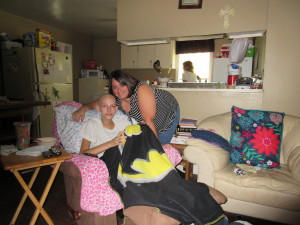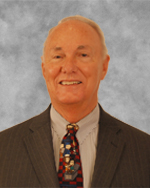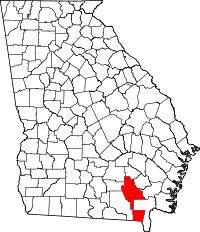State public health officials emphasized this week that they’re evaluating rare childhood cancers in South Georgia “with great intensity.”
“We’re taking it very seriously,’’ Dr. Patrick O’Neal, director of health protection at the state Department of Public Health, told GHN.
O’Neal said Wednesday that based on new information, Public Health has confirmed three childhood cases of rhabdomyosarcoma and one case of Ewing sarcoma in and near Ware County, in the southeast corner of Georgia.
Relatives and community members say the four cases were diagnosed within two months of one another this summer.
The cancers have reignited fears in the community that there is a connection to where they live, and raised fears of a link to the history of industrial contamination in the Waycross area. (Here’s a link to a recent GHN story on the cancers.)
There are only 350 new cases of rhabdomyosarcoma each year in the United States, according to the American Cancer Society. The annual incidence of Ewing sarcoma is one case per every 1 million Americans, though the figure is somewhat higher for children, according to the National Cancer Institute.
Dr. Sharon Savage, chief of the Clinical Genetics Branch of the Division of Cancer Epidemiology and Genetics at the NCI, said:
“There are no established environmental risk factors for either rhabdomyosarcoma or Ewing’s sarcoma. It is difficult to identify the specific causes of most cancers, but particularly challenging for rare malignancies.”
O’Neal’s comments revised an earlier assessment by Public Health that just two rhabdomyosarcomas existed in Ware and Brantley counties, and that one child cancer was diagnosed a year ago — not in the time frame of the other cases.

The earlier statements by the agency had done little to ease concerns of people in the greater Waycross area, who have called for more testing of the water, soil and air in the area for possible pollutants.
Community members who were told of O’Neal’s comments said Thursday that they welcomed an intensive study by state health officials.
O’Neal acknowledged this week that it was unusual to find the three cases of rhabdomyosarcoma in one area, but he added that health officials can’t say anything about possible causes at this point.
Public Health will be working with other agencies in investigating the cancers, O’Neal said.
He also emphasized that the investigation “will take much longer than anyone would like,” and he urged community members and health care officials in the area to contact the agency with any new information.
Thorough analysis takes time
Georgia has a strong registry of cancer cases, but it often takes six to 12 months for clinicians to send information. “It’s not immediate reporting,’’ O’Neal said.
Joan Tibor, who has helped compile data on cancer among children in the Waycross area, said Thursday that she hoped Public Health would study all childhood cancers in the area. Tibor and another community member have developed a list 16 of children in Ware and Pierce counties who have been diagnosed with cancer since 2011.
State Rep. Jason Spencer (R-Woodbine), whose district includes Ware County, said he wants state officials to take a comprehensive approach to the probe.
Health officials shouldn’t just look at a single town or county, he said. “We need to be more inclusive.”
“I want them to really dive into this issue,’’ said Spencer, a physician assistant. “These things are hard to evaluate, and I know that.” But he added, “These sarcomas have very similar cellular lineages.”
A cancer cluster is defined as a greater-than-expected number of cancer cases that occur within a group of people in a geographic area over a period of time. Such clusters are very difficult to prove.
Each case must either be the same type, or derived from the same cause.
One problem with establishing direct causation in particular cases is the huge overall incidence of cancer. As the CDC points out, it is the second-leading cause of death in the United States. Nationwide, one out of four deaths are due to some type of cancer.
O’Neal noted that the CDC has “a fairly rigid definition of a cancer cluster.”
Spencer said he recognizes that health officials must follow scientific protocols. But this situation, he said, may take more than a “cookie-cutter approach.’’


